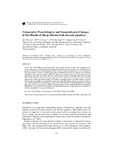| dc.contributor.author | Waweru, JG | |
| dc.contributor.author | Kanyari, PW | |
| dc.contributor.author | Mwangi, DM | |
| dc.contributor.author | Ngatia, TA | |
| dc.contributor.author | Nansen, P | |
| dc.date.accessioned | 2013-06-13T12:21:13Z | |
| dc.date.available | 2013-06-13T12:21:13Z | |
| dc.date.issued | 1999-12 | |
| dc.identifier.citation | Trop Anim Health Prod. 1999 Dec;31(6):363-72. | en |
| dc.identifier.uri | http://hinari-gw.who.int/whalecomwww.ncbi.nlm.nih.gov/whalecom0/pubmed/10599131 | |
| dc.identifier.uri | http://erepository.uonbi.ac.ke:8080/xmlui/handle/123456789/33065 | |
| dc.description.abstract | Twelve each of Red Masai and Dorper sheep, aged between 6 and 9 months, were acquired from a Fasciola-free area of eastern Kenya. Each breed was divided into two groups of 6. The sheep in one group of each breed were experimentally infected with 400 viable metacercariae of Fasciola gigantica. The other group of 6 sheep of each breed remained as uninfected controls. The animals were monitored regularly for any evidence of disease. Blood samples taken weekly revealed a general reduction in red cell counts and packed cell volume, which was much faster in the infected Dorper sheep than in the Red Masai. This reduction started from the tenth week after infection and persisted to the end of the experiment 18 weeks post infection (PI). The absolute eosinophil counts rose in all the infected animals, but the values were higher among the Dorper than among the Red Masai. Patency occurred at weeks 12 and 13 PI in the Red Masai and Dorpers, respectively, with the latter shedding significantly more fluke eggs. The worm recovery rates were higher among the Dorpers than among the Red Masai, though not significantly so. On the basis of egg counts and clinicopathology, the Dorper sheep were considered to be more susceptible to F. gigantica infections. | en |
| dc.language.iso | en | en |
| dc.publisher | University of Nairobi. | en |
| dc.title | Comparative parasitological and haematological changes in two breeds of sheep infected with Fasciola gigantica | en |
| dc.type | Article | en |
| local.publisher | Department of Veterinary Pathology and Microbiology, Faculty of Veterinary Medicine, University of Nairobi, Kenya. | en |

